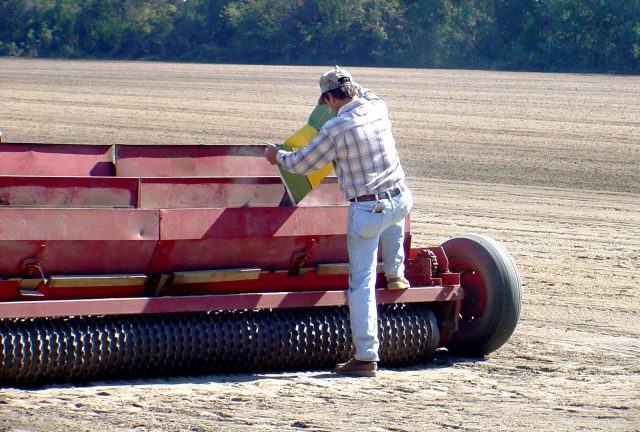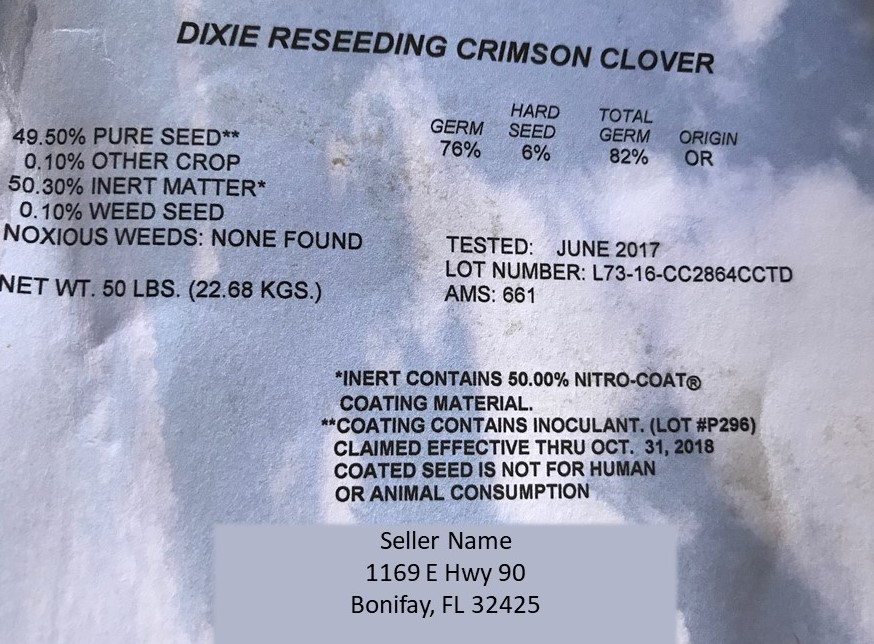
Useful information is provided on every bag of certified seed. Make sure you know what you are buying by reviewing the seed tag before making the investment. Photo credit: Doug Mayo
Fall is here so it is time to prepare for winter grazing. Once you determine the variety(s) you will be planting (2017 Cool-Season Forage Variety Recommendations for Florida), the next step is to order and purchase the seed. However, not all seed is equal. While most cattlemen are familiar with reading feed tags, you may not be as familiar with the information provided on the tags of seed bags. Just as the feed tag provides vital information about the product in the bag, so too does a seed tag. Like many other purchasing decisions, it is important to know the details before you make the purchase.

Many legumes seeds are bagged with a coating that contains the correct inoculant for that variety. Based on the information provided on this seed tag, only 25 lbs are actual seeds. Credit Dr. Jose Dubeux
The following are commonly found on all certified seed tags: Name, Lot Number, Purity, Other Crop, Inert, Weed Seed, Noxious Weeds, Germination, Dormant or Hard Seed, Total Viability, Origin, Date Tested, Net Weight, and the Name and Address of the Seller. Full definitions of these can be found in the NRCS Factsheet: A Guide to Understanding Seed Tags. Most of these components are easily interpreted, however there a few key points to keep in mind:
- Purity, inert, other crop and weed seed are reported as a percentage, while noxious weeds are reported as total number of weed seeds per pound of seed.
- Total Viability is the combination of immediate and dormant or hard seed germination. Example: if germination = 76% and dormant = 6%, the total viability would be 82%. This means that the vast majority of the seed will germinate right away, but a small percentage will sprout some time later. The hard seed provides some insurance of a stand, if conditions immediately after planting become unfavorable.
- If other crop is over 5%, the crops it contains must be listed on the tag.
- The Test Date gives you an idea how fresh the seed is. The Southern Seed Certification Association requires retesting of germination and purity for re-certification of seed carried over from the previous season.
Keep in mind that state law requires each bag of certified seed to be tagged, and include a lot number. It is a great practice to save at least one seed tag for your records until the end of the growing season. This allows for traceability of the seed, if there is a major stand issue, or a question about the crop that was planted.
More information on seed certification standards and procedures, and the noxious weed list can be found in the following fact sheet:
General Seed Certification Standards of the Southern Seed Certification Association
- Big Doe Contest Returns for 2025: A Growing Thanksgiving Tradition - November 14, 2025
- UF/IFAS Extension Panhandle Cattlemen’s College Announces Scholarship Opportunity for Florida Youth – Application Deadline September 15 - August 29, 2025
- Foot Rot Prevention and Treatment for Cattle - August 15, 2025
